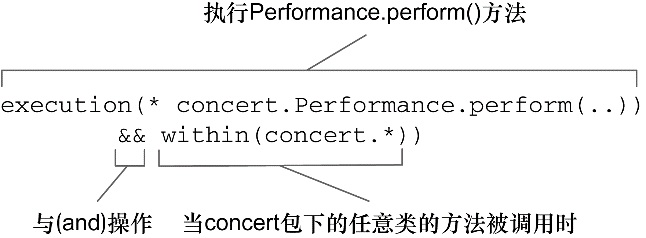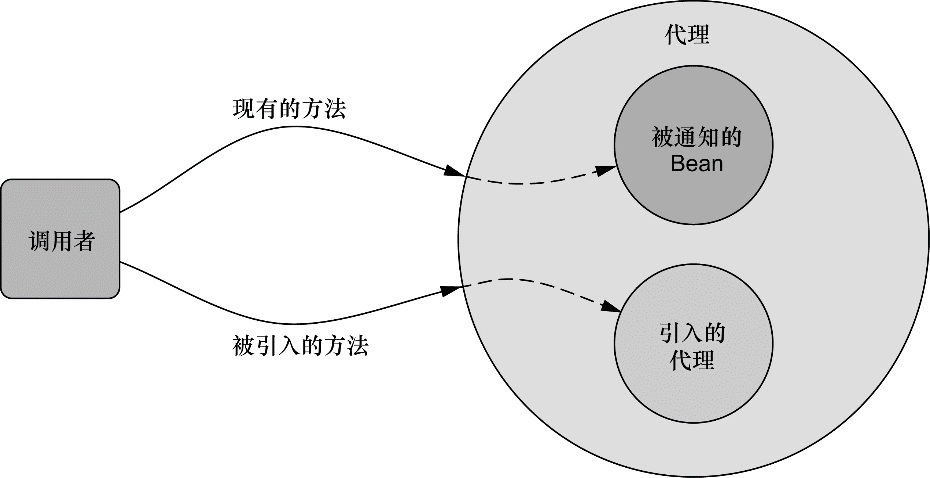面向切面编程(AOP)术语
通知(Advice)
切面的工作被称为通知
通知定义了切面是什么以及何时使用。
Spring 切面可以应用 5 种类型的通知:
- 前置通知(Before):在目标方法被调用之前调用通知功能
- 后置通知(After):在目标方法完成之后调用通知,此时不会关心方法的输出是什么
- 返回通知(After-returning):在目标方法成功执行之后调用通 知
- 异常通知(After-throwing):在目标方法抛出异常后调用通知
- 环绕通知(Around):通知包裹了被通知的方法,在被通知的方法调用之前和调用之后执行自定义的行为
连接点(Join point)
连接点是在应用执行过程中能够插入切面的一个点。这个点可以是调用方法时、抛出异常时、甚至修改一个字段时。切面代码可以利用这些点插入到应用的正常流程之中,并添加新的行为。
切点(Poincut)
切点是通知所要织入的一个或多个连接点。我们通常使用明确的类和方法名称,或是利用正则表达式定义所匹配的类和方法名称来指定这些切点。有些 AOP 框架允许我们创建动态的切点,可以根据运行时的决策(比如方法的参数值)来决定是否应用通知。
切面(Aspect)
切面是通知和切点的结合。通知和切点共同定义了切面的全部内容 —— 它是什么,在何时和何处完成其功能。
引入(Introduction)
引入允许我们向现有的类添加新方法或属性。
织入(Weaving)
织入是把切面应用到目标对象并创建新的代理对象的过程。切面在指定的连接点被织入到目标对象中。
在目标对象的生命周期里有多个点可以进行织入:
- 编译期:切面在目标类编译时被织入。这种方式需要特殊的编译器。AspectJ 的织入编译器就是以这种方式织入切面的。
- 类加载期:切面在目标类加载到 JVM 时被织入。这种方式需要特殊的类加载器(ClassLoader),它可以在目标类被引入应用之前增强该目标类的字节码。AspectJ 5 的加载时织入(load-time weaving,LTW)就支持以这种方式织入切面。
- 运行期:切面在应用运行的某个时刻被织入。一般情况下,在织入切面时,AOP 容器会为目标对象动态地创建一个代理对象。Spring AOP 就是以这种方式织入切面的。
Spring 提供的 AOP 支持
Spring 提供了 4 种类型的 AOP 支持:
- 基于代理的经典 Spring AOP;
- 纯 POJO 切面;
- @AspectJ 注解驱动的切面;
- 注入式 AspectJ 切面(适用于 Spring 各版本)
Spring 在运行时通知对象
通过在代理类中包裹切面,Spring 在运行期把切面织入到 Spring 管理的 bean 中。代理类封装了目标类,并拦截被通知方法的调用,再把调用转发给真正的目标 bean。当代理拦截到方法调用时,在调用目标 bean 方法之前,会执行切面逻辑。
直到应用需要被代理的 bean 时,Spring 才创建代理对象。如果使用的是 ApplicationContext 的话,在 ApplicationContext 从 BeanFactory 中加载所有 bean 的时候,Spring 才会创建被代理的对象。因为 Spring 运行时才创建代理对象,所以不需要特殊的编译器来织入 Spring AOP 的切面。
Spring 只支持方法级别的连接点
因为 Spring 基于动态代理,所以 Spring 只支持方法连接点。
其他的 AOP 框架例如 AspectJ 和 JBoss,除了方法切点,还提供了字段和构造器接入点。
Spring 缺少对字段连接点的支持,无法创建细粒度的通知,例如拦截对象字段的修改。而且它不支持构造器连接点,无法在 bean 创建时应用通知。
通过切点来选择连接点
Spring 仅支持 AspectJ 切点指示器(pointcut designator)的一个子集
| AspectJ 指示器 | 描 述 |
|---|---|
| execution() | 用于匹配是连接点的执行方法 |
| arg() | 限制连接点匹配参数为指定类型的执行方法 |
| @args() | 限制连接点匹配参数由指定注解标注的执行方法 |
| this() | 限制连接点匹配AOP代理的bean引用为指定类型的类 |
| target | 限制连接点匹配目标对象为指定类型的类 |
| @target() | 限制连接点匹配特定的执行对象,这些对象对应的类要具有指定类型的注解 |
| within() | 限制连接点匹配指定的类型 |
| @within() | 限制连接点匹配指定注解所标注的类型(当使用Spring AOP时,方法定义在由指定的注解所标注的类里) |
| @annotation | 限定匹配带有指定注解的连接点 |
只有execution()指示器是实际用来执行匹配的,而其他的指示器都是用来限制匹配的。execution()指示器是在编写切点定义时最主要使用的指示器。
编写切点
设置当perform()方法执行时触发通知的调用,如下图所示:

使用execution()指示器选择Performance的perform()方法。方法表达式以*号开始,表明任意方法返回值的类型。然后指定全限定类名和方法名。对于方法参数列表,使用两个点号(..)表明切点要选择任意的perform()方法,无论该方法的入参是什么。
假设我们需要配置的切点仅匹配concert包。在此场景下,可以使用within()指示器来限制匹配,如下图所示:

在切点中选择 bean
Spring 的bean()指示器允许在切点表达式中使用 bean 的 ID 来标识 bean。bean()使用 bean ID 或 bean 名称作为参数来限制切点只匹配特定的 bean。
execution(* concert.Performance.perform()) and bean('woodstock')使用非操作为除了特定 ID 以外的其他 bean 应用通知。
execution(* concert.Performance.perform()) and !bean('woodstock')定义切面
普通通知
使用@Aspect注解声明这是一个切面类。
使用@Pointcut注解定义切面内可重用的切点,这样之后的通知注解中可以直接使用定义的切点,不嫌麻烦可以使用重复的@Before("execution( concert.Performance.perform(..))")。
在该类添加@Component注解或者使用@bean将该类注册成 bean。
@Aspect
public class Audience {
@Pointcut("execution(* concert.Performance.perform(..))")
public void performance() { }
@Before("performance()")
public void silenceCellPhones() {
System.out.println("Silencing cell phones");
}
@Before("performance()")
public void takeSeats() {
System.out.println("Taking seats");
}
@AfterReturning("performance()")
public void applause() {
System.out.println("CLAP CLAP CLAP!!!");
}
@AfterThrowing("performance()")
public void demandRefund() {
System.out.println("Demanding a refund");
}
}此时这个类并不会被视为切面,要启用切面的代理需要使用 JavaConfig,在 config 上使用@EnableAspectJAutoProxy注解来启用自动代理功能。
@Configuration
@EnableAspectJAutoProxy
@Component
public class ConcertConfig {
@Bean
public Audience audience() {
return new Audience();
}
}@EnableAspectJAutoProxy注解 AOP 也能正常使用,这是因为 Spring Boot 中存在spring-boot-autoconfigure依赖,默认会注入AopAutoConfiguration配置类,该类的作用等同于@EnableAspectJAutoProxy注解,所以在这种情况下可以不加该注解,AopAutoConfiguration是否启用可以通过spring.aop.auto属性控制
环绕通知
@Around("performance()")
public void watchPerformance(ProceedingJoinPoint jp) {
try {
System.out.println("Silencing cell phones");
System.out.println("Taking seats");
jp.procee();
System.out.println("CLAP CLAP CLAP!!!");
} catch (Throwable e) {
System.out.println("Demanding a refund");
}环绕通知 = 前置通知 + 目标方法执行 + 后置通知
环绕通知接收ProceedingJoinPoint作为必需的参数,调用ProceedingJoinPoint的proceed()方法实现目标方法执行,在该方法前后的内容实现前置通知和后置通知。如果不调用proceed()方法会阻塞对被通知方法的调用,如果多次调用proceed()方法能实现对方法的多次调用。
处理通知中的参数
切面要访问和使用传递给被通知方法(目标方法)的参数的情况
@Aspect
public class TrackCounter {
private Map<Integer, Integer> trackCounts = new HashMap<>();
@Pointcut("execution(* soundsystem.CompactDisc.playTrack(int) && args(trackNumber))")
public void trackPlayed(int trackNumber) { }
@Before("trackPlayed(trackNumber)")
public void countTrack(int trackNumber) {
int currentCount = getPlayCount(trackNumber);
trackCounts.put(trackNumber, currentCount + 1);
}
}下面具体分析:

playTrack括号中的int表示匹配到方法参数为int的方法。&&之后的args表示传递目标方法中的参数到通知方法中,参数名为trackNumber,对应的通知方法的形参中的参数名要相同。
当需要传递多个参数时,注解中不需要args,只需为通知方法添加一个参数作为第一个形参,类型为org.aspectj.lang.JoinPoint,它提供了getArgs()之类的方法可以获取所有参数和其他值。
通知方法参数相关详情请看官方文档Declaring Advice :: Spring Framework。
通过切面为 bean 添加新功能
实现
官方文档Introductions :: Spring Framework
在 Spring 中,切面实现了它们所包装 bean 的相同接口,如果除了实现这些接口,代理还暴露新的接口,这样看起来就像 bean 引入了新方法。当引入接口的方法被调用时,代理会把此调用委托给实现了新接口的某个实现类,因此一个 bean 的实现被拆分到了多个类中。如下图所示:

下面是示例代码:
public interface Encoreable {
void performEncore();
}
@Aspect
public class EncodeableIntroducer {
@DeclareParents(value="concert.Performance+",
defaultImpl=DefaultEncoreable.class)
public static Encoreable encoreable;
}Encoreable接口类为需要向 bean 添加的新接口,其中的performEncore()方法就是新接口方法。EncodeableIntroducer类为切面,实现引入功能,同样要将该类注册为 bean。
通过@DeclareParents注解,将Encoreable接口引入到Performance bean中。分为三部分:
value属性指定了要将接口引入到哪个类型的 bean。在本例中,也就是所有Performance类型。(标记符后面的加号表示是Performance的所有子类型,而不是Performance本身。)defaultImpl属性指定了为引入功能提供实现的类,即引入接口的实现类。@DeclareParents注解所标注的静态属性指明了要引入的接口。
调用
有两种方法
强制转换
强制转换类型为新添加的接口类型。
public class SpringDeclareParentsTest {
public static void main(String[] args) {
//1.创建容器
AnnotationConfigApplicationContext ac = new AnnotationConfigApplicationContext(SpringConfiguration.class);
//2.获取对象
Performance performance = ac.getBean("performance",Performance.class);
//3.自行强转
Encoreable encoreable = (Encoreable)performance;
//4.调用添加的方法
encoreable.performEncore();
//5.调用目标类中的方法。
performance.perform();
}
}使用this关键字
在通知类中,使用this关键字,引入新目标类对象,调用方法。
@Component
@Aspect
public class EncodeableIntroducer {
@DeclareParents(value="concert.Performance+",
defaultImpl=DefaultEncoreable.class)
public static Encoreable encoreable;
@Before("execution(* *.*.(..)) && this(encoreable)")
public void printlog(Encoreable encoreable){
encoreable.performEncore();
}
}
public class SpringDeclareParentsTest {
public static void main(String[] args) {
//1.创建容器
AnnotationConfigApplicationContext ac = new AnnotationConfigApplicationContext(SpringConfiguration.class);
//2.获取对象
Performance performance = ac.getBean("performance",Performance.class);
//3.调用目标类中的方法。
performance.printlog();
}
}